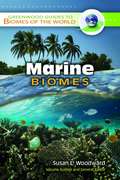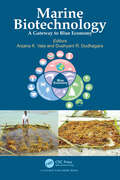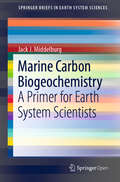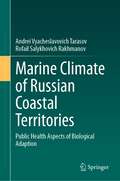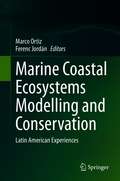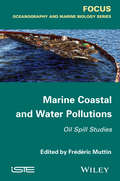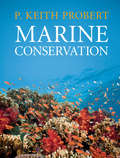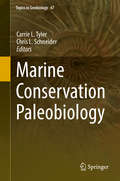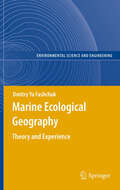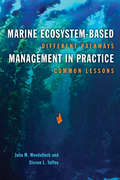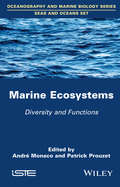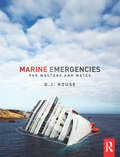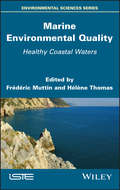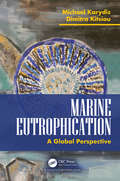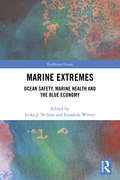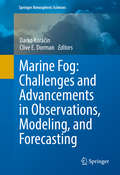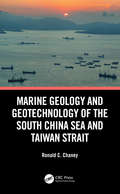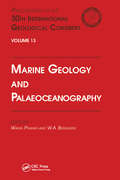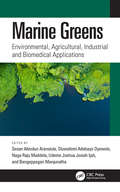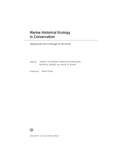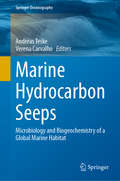- Table View
- List View
Marine Biomes (Greenwood Guides to Biomes of the World)
by Susan L. WoodwardThis book is arranged with an introductory section on marine biomes followed by chapters on coast, continental shelf, and deep sea biomes. Each of the chapters contains an overview of the biome on a global scale followed by selected regional examples. Woodward (retired, biogeography and physical geography, Radford U.) includes a glossary of terms and prefers to not use Latin names in the text, though she concludes each chapter with a concordance of English and Latin terminology. This publication can be used in tandem with other books on biomes in the series. Annotation ©2008 Book News, Inc., Portland, OR (booknews.com)
Marine Bioprospecting for Sustainable Blue-bioeconomy
by Naga Raju Maddela Sesan Abiodun Aransiola Olabisi Peter Abioye Abayomi BamisayeThis volume comprehensively discusses marine bioprospecting and its applications in the marine bioeconomy, specifically in clean energy generation, and in biomedical, industrial and agricultural sectors. The advent of modern technology, particularly advancements in deep-sea exploration and biotechnology, has enabled scientists to delve deeper into the ocean's depths and discover a treasure trove of unique organisms and compounds. This demonstrates that the rich history of human interactions with the oceans is firmly ingrained in marine bioprospecting. The blue-economy, which is a more accurate name for the systematic search for valuable substances and organisms in the water, has gained popularity in recent years as a possible route for sustainable economic development. One of the key driving factors behind marine bioprospecting is the growing realization that marine organisms possess unique biochemical compounds with the potential to revolutionize various industries. These compounds include novel enzymes, antimicrobial agents, bioactive molecules, and even potential pharmaceuticals. Readers will learn about the applications of these discoveries in bioremediation, wastewater treatment, and biofuel production, as well as the identification of natural substitutes for things that are detrimental to the environment, which include biodegradable plastics derived from marine microorganisms. The primary audience for the book will be governmental and international organizations, professionals, and economists, while the secondary audience will be professors and researchers in the fields of Chemistry, Biotechnology, Environmental Microbiology, and general Ocean Sciences.
Marine Biotechnology: A Gateway to Blue Economy
by Anjana K. Vala Dushyant R. DudhagaraThe marine environment has always been beneficial to mankind in one way or another. With advancements in scientific knowledge and technological development, novel aspects of marine resources have been and are being revealed that can be harnessed for sustainable development of blue economy. The book Marine Biotechnology: A Gateway to Blue Economy is an attempt to present before the scientific community, a compilation of recent developments in the field of marine biotechnology contributed by leading scientists of international repute. The book covers diverse roles of marine biotechnology, including in agriculture, probiotics, health sector, novel biomolecules, biochemicals, biomedicine, and pharmaceuticals.
Marine Carbon Biogeochemistry: A Primer For Earth System Scientists (SpringerBriefs in Earth System Sciences)
by Jack J. MiddelburgThis open access book discusses biogeochemical processes relevant to carbon and aims to provide readers, graduate students and researchers, with insight into the functioning of marine ecosystems. A carbon centric approach has been adopted, but other elements are included where relevant or needed. The book focuses on concepts and quantitative understanding of primary production, organic matter mineralization and sediment biogeochemistry. The impact of biogeochemical processes on inorganic carbon dynamics and organic matter transformation are also discussed.
Marine Climate of Russian Coastal Territories: Public Health Aspects of Biological Adaption
by Andrei Vyacheslavovich Tarasov Rofail Salykhovich RakhmanovThe monograph was written based on the material of the post-doctoral thesis prepared under the supervision of Prof. Dr. Rakhmanov and it has been translated from its original version in Russian. It presents a comprehensive analysis of the process of biological adaptation and adaptation capacity of the population to the marine climate of Russia’s North, the Black and Caspian Sea regions and the Baltic Sea coast. The authors explore different biological reactions to adaptation and offer their classification depending on the type of climate. Special attention is given to the prevention of prenosological conditions and diseases typical of coastal areas. Evidence suggests that the human body has a remarkable capacity to adapt to a range of climatic and weather conditions through a variety of targeted adaptation measures.
Marine Coastal Ecosystems Modelling and Conservation: Latin American Experiences
by Marco Ortiz Ferenc JordánThe book presents a collection of large-scale network-modeling studies on coastal systems in Latin America. It includes a novel description of the functioning of coastal complex ecosystems and also predicts how natural and human-made disturbances percolate through the networks. Coastal areas belong to the most populated ecosystems around the globe, and are massively influenced by human impacts such as shipping, mining, fisheries, tourism, pollution and human settlements. Even though many of these activities have facilitated socio-economic development, they have also caused a significant deterioration in natural populations, communities and ecosystems worldwide. Covering coastal marine ecosystems of Latin America such as the NE and SE Pacific, NW Atlantic and Caribbean areas, it discusses the construction of quantitative (Ecopath-Ecosim-Ecospace and Centrality of Node Sets) and semi-quantitative (Loop Analysis) multispecies trophic-network models to describe and assess the impacts of natural and human interventions like pelagic and benthic fishing as well as natural events such as El Niño, and La Niña. The book also features steady state (and/or near moving equilibrium) and dynamical models to support the management of exploited organisms, and applies and quantifies macroscopic indices, based on Ascendency (Ulanowicz) and Local Stability (Levins´ Loop Analysis). Further, it discusses the determination of the Keystone Species Complex Index, which is a holistic extension of the classical concept of Keystone Species (Paine), offering novel strategies for conservation monitoring and management.
Marine Coastal and Water Pollutions: Oil Spill Studies
by Frédéric MuttinIdentifying efficient solutions to protect coastal regions from marine pollution requires expertise from a range of specialties and strategic approaches. This book gathers information on the impact of oil spills at a coastal level from different experts’ points of view, identifying synergies between domains such as mathematics, numerical modeling, mechanics, biology, economics and law. The collaborative research presented here is based on the 4th International Workshop on Anti-Pollution and Marine Coastal Water Pollution, held in La Rochelle, France at the Engineering School EIGSI, in April 2012. The areas addressed include: materials and structures (fluid-structure and capture interaction, cable and membrane equations, optimization); coastal hydrodynamics (computational fluid dynamics, numerical analysis of shallow water equations, analytical and numerical derivatives); biological impacts (biology, multivariate analysis, indicators); and economics and law (compensation costs, insurance coverage, coastal vulnerability).
Marine Conservation
by Probert P. KeithProviding a comprehensive account of marine conservation, this book examines human use and abuse of the world's seas and oceans and their marine life, and the various approaches to management and conservation. Healthy marine ecosystems - the goods and services that they provide - are of vital importance to human wellbeing. There is a pressing need for a global synthesis of marine conservation issues and approaches. This book covers conservation issues pertinent to major groups of marine organisms, such as sharks, marine turtles, seabirds and marine mammals; key habitats, from estuaries, wetlands and coral reefs to the deep sea; and from local and regional to international initiatives in marine conservation. An ideal resource for students, researchers and conservation professionals, the book pays appropriate attention to the underlying marine biology and oceanography and how human activities impact marine ecosystems, enabling the reader to fully understand the context of conservation action and its rationale.
Marine Conservation Paleobiology (Topics in Geobiology #47)
by Carrie L. Tyler Chris L. SchneiderThis volume describes and explores the emerging discipline of conservation paleobiology, and addresses challenges faced by established and young Conservation Paleobiologist's alike. In addition, this volume includes applied research highlighting how conservation paleobiology can be used to understand ecosystem response to perturbation in near and deep time. Across 10 chapters, the book aims to (1) explore the goals of conservation paleoecology as a science, (2) highlight how conservation paleoecology can be used to understand ecosystems’ responses to crises, (3) provide case studies of applications to modern ecosystems, (4) develop novel applications of paleontological approaches to neontological data, and (5) present a range of ecosystem response and recovery through environmental crises, from high-resolution impacts on organism interactions to the broadest scale of responses of the entire marine biosphere to global change. The volume will be of interest to paleoecologists, paleobiologists, and conservation biologists.
Marine Distributions (The Royal Society of Canada Special Publications #5)
by Maxwell DunbarA symposium of the Royal Society of Canada was held in June 1962 to outline what is being done in Canadian oceanography to map salinity, temperature, and plankton in the waters around Canada and in the North Atlantic across to Europe. This volume, based on the symposium, emphasizes the interdisciplinary nature of research in marine biogeography and in the distribution of environmental factors in the sea. The book is intended to show the breadth of biogeographic work in the sea, and the relation between biogeography and the physics and chemistry of the marine environment. It serves also to introduce to the scientific public the new Serial Atlas of the Marine Environment, a scientific journal of a new kind of sponsored jointly by the Royal Society of Canada and the U.S. National Academy of Sciences.
Marine Ecological Geography
by Dmitry Ya FashchukIn Chapter 1 the methodological principles of systemization and visualization of multidimensional ecological information for its operational dissemination among potential users are stated. Their realization results in creation of the geographic-and ecologic model of marine basin as an information base for diagnosis of the marine ecosystem state, estimation of consequences of economic activity, and modelling of its changes with the use of mathematical tools. In Chapter 2 the geographic-and-ecological aspects of mathematical modelling of marine ecosystems, the possibilities and peculiarities of the most adequate models, the Russian hydrodynamic model of oil spills "SPILLMOD" and hydroecological model of organogenic compound transformation in the sea, are investigated. In the following six Chapters the examples of practical realization of geographic-and-ecological (as information source) and mathematical (as computing apparatus) modelling at the investigations of specific ecological problems associated with consequences of natural hazards and economic activity on aquatory and within the whole Black Sea basin are given.
Marine Ecosystem-Based Management in Practice: Different Pathways, Common Lessons
by Julia M. Wondolleck Steven Lewis YaffeeWhat are the key ingredients of successful marine ecosystem planning? The surprising answer, according to authors Julia Wondolleck and Stephen Yaffee, is that a successful approach calls for more than just sound organizational structure and resources, but also a comfortable atmosphere of trust, understanding, and collaboration.Marine Ecosystem-Based Management in Practice is the first practical guide for the marine conservation realm. In a unique collection of case studies, the authors showcase successful collaborative approaches to ecosystem-based management. This book offers a hopeful message to policy makers, managers, practitioners, and students who will find this an indispensable guide to field-tested, replicable marine conservation management practices that work.
Marine Ecosystems
by Patrick Prouzet André MonacoIn a perspective of sustainable management, the balance between ecological dynamics, social and economic are now at the heart of ecological modeling and environmental strategies screenwriting. Diversity and marine ecosystems function illustrates biodiversity, habitat diversity, structures and food webs in various oceans of the world and systems: pelagic and benthic ecosystems, coral reefs and seagrass beds, oasis of hydrothermal vents ridges or areas rich upwelling. Appropriate observation methods, long-term monitoring and modeling reveal the complexity of systems, trophic interactions and spatiotemporal dynamics. The ecosystem approach is a prerequisite to assess the state of these systems, their living resources and ecological services involved in local and global environmental changes.
Marine Emergencies: For Masters and Mates
by David HouseAn influential guide to maritime emergencies and the current strategies that can be employed to cope with the immediate after effects and ramifications of disaster at sea. Many mariners will at some point in their maritime careers become involved in one sort of emergency or another, while in port or at sea, whether it is a fire on board, a collision with another vessel or an engine failure threatening a lee shore. Actions to take in such incidents can be the difference between survival and catastrophic loss. This text provides a direct insight into some of the latest incidents and includes: case studies from emergencies worldwide checklists and suggestions for emergency situations. everything from fire and collision right through to the legal implications of salvage. David House has now written and published eighteen marine titles, many of which are in multiple editions. After commencing his seagoing career in 1962, he was initially engaged on general cargo vessels. He later experienced worldwide trade with passenger, container, Ro-Ro, reefer ships and bulk cargoes. He left the sea in 1978 with a Master Mariner's qualification and commenced teaching at the Fleetwood Nautical College. He retired in 2012 after thirty three years of teaching in nautical education. He continues to write and research maritime aspects for future works.
Marine Environmental Quality: Healthy Coastal Waters
by Frédéric Muttin Hélène ThomasUnderstanding marine pollution and the contamination of coastal environments requires knowledge from a variety of scientific fields. Marine Environmental Quality promotes a multidisciplinary approach to investigations, drawing on not only natural sciences, but also applied mathematics and social sciences.The investigations in this book focus on both organic and inorganic pollutants, firstly in a study conducted in the city of La Rochelle, on the North Atlantic French coast, then expanding the areas under examination to regions of English and Portuguese waters and, lastly, to the Mediterranean Sea. The improvement such research can bring to biomarkers, models and experiments enables equal progress in the quality of seawater in ports and protected areas of coastal regions.The eight chapters of Marine Environmental Quality present many aspects of this research, including experiments with floating barriers, water governance in various areas, sampling sites and sentinel species that act as biomarkers in harbors. Also covered are environmental commitments, both international and local, the risk that marine contamination poses to human health, experimental designs for interactions with microplastics and a study biomonitoring the juveniles of sentinel species. Such results will bring many benefits, to human health, to economic inclusion and to regional development.
Marine Eutrophication: A Global Perspective
by Michael Karydis Dimitra KitsiouMarine eutrophication has been recognized as a global problem with adverse effects on ecosystem’s health and the economies of coastal states. Most conventions regarding marine environmental protection of Regional Seas have given priority to eutrophication and relevant management practices. This book presents a global perspective of eutrophication in most of the Regional Seas, including the legal framework, assessment and management practices. Information on ecosystem’s impact as well as an outline of the methods used for assessing eutrophication is also provided. This volume will be useful to research students, marine scientists and policy makers working in marine environmental management. Key Features: Contributes to the understanding of the eutrophication processes and problems Presents an extensive account of the data analysis methods used for the quantitative assessment of eutrophication Looks the eutrophication status of the main regional seas Provides information on eutrophication politics and measures to mitigate eutrophication
Marine Extremes: Ocean Safety, Marine Health and the Blue Economy (Earthscan Oceans)
by Erika Techera Gundula WinterMarine extremes, as they are conceived of in this volume, encompass environments, activities, events and impacts. Extreme environments found in and around our oceans, including the deep sea and seabed as well as the frozen polar regions, are being seriously affected by both extreme behaviours (dumping and discharge of waste, illegal fishing and piracy) and extreme events (storms, tsunamis, extreme waves and marine heatwaves). <P><P>The aim of this book is to highlight the multi-disciplinary knowledge and inputs needed to address marine extremes and thereafter to explore opportunities and current challenges. Safe and healthy oceans are important for economic, recreational and cultural activities, in addition to the maintenance of ecosystem services upon which we rely. This volume gathers a unique mix of researchers working on scientific aspects of biological ecosystems and physical processes together with social scientists exploring law and governance options, community preferences, cultural values, economic aspects and criminological drivers and approaches. The multi-disciplinary feature of this book breaks down barriers that arise between disparate fields of research so that integrated solutions to ocean challenges can be found. Overall, this book argues that if we are to achieve sustainable utilisation of our oceans and blue economy goals we must better understand, and respond to, the extreme environments, activities, events and impacts. <P><P>The book is a valuable addition to the literature and will be of interest to researchers in marine science, ocean governance and natural resource economics, as well as to professionals and government officials concerned with marine policy and planning.
Marine Fog: Challenges and Advancements in Observations, Modeling, and Forecasting (Springer Atmospheric Sciences)
by Darko Koračin Clive E. DormanThis volume presents the history of marine fog research and applications, and discusses the physical processes leading to fog's formation, evolution, and dissipation. A special emphasis is on the challenges and advancements of fog observation and modeling as well as on efforts toward operational fog forecasting and linkages and feedbacks between marine fog and the environment.
Marine Geochemistry
by Tim D. Jickells Roy ChesterMarine Geochemistry offers a fully comprehensive and integrated treatment of the chemistry of the oceans, their sediments and biota. The first edition of the book received strong critical acclaim and was described as 'a standard text for years to come.' This third edition of Marine Geochemistry has been written at a time when the role of the oceans in the Earth System is becoming increasingly apparent. Following the successful format adopted previously, this new edition treats the oceans as a unified entity, and addresses the question 'how do the oceans work as a chemical system?' To address this question, the text has been updated to cover recent advances in our understanding of topics such as the carbon chemistry of the oceans, nutrient cycling and its effect on marine chemistry, the acidification of sea water, and the role of the oceans in climate change. In addition, the importance of shelf seas in oceanic cycles has been re-evaluated in the light of new research.Marine Geochemistry offers both undergraduate and graduate students and research workers an integrated approach to one of the most important reservoirs in the Earth System.Additional resources for this book can be found at: www.wiley.com/go/chester/marinegeochemistry.
Marine Geology and Geotechnology of the South China Sea and Taiwan Strait
by Ronald C. ChaneyThe waters and rich resources of the South China Sea are claimed by seven different countries, and it is estimated that approximately 40% of the world’s trade moves through the area. Marine Geology and Geotechnology of the South China Sea and Taiwan Strait examines the physiology, geology, and potential development of this important portion of the western Pacific Ocean’s largest marginal sea. The book covers multiple oceanographic topics, and further discusses topography, sedimentation, wave generation, and hazards such as earthquakes, storm surges, and tsunamis. In addition, it explains the engineering issues and design considerations involved regarding a potential Taiwan Strait Crossing, as well as the development of near-shore communities. Features: Examines seabed material, such as clays, calcareous, siliceous, and various other organic sediments Presents different potential routing strategies for sea crossings using tunnels, bridges, or a combination of both Provides bridge design recommendations considering aesthetics, seismic and wind issues, potential vessel collisions, and more Includes a historical timeline and useful maps regarding the political complexity of the area and the various territorial claims made by different nations Marine Geology and Geotechnology of the South China Sea and Taiwan Strait serves as a valuable resource for geotechnical engineers, marine geologists, civil engineers, and professionals concerned with the region.
Marine Geology and Palaeoceanography: Proceedings of the 30th International Geological Congress, Volume 13
by Wang Pinxian W. A. BerggrenThis volume presents the proceedings of Symposium on Marine Geology and Palaeoceanography of the 30th International Geological Congress at Beijing. The proceedings aim to present a view of contemporary marine geology and should be of interest to researchers in the geological science.
Marine Greens: Environmental, Agricultural, Industrial and Biomedical Applications
by Sesan Abiodun Aransiola, Oluwafemi Adebayo Oyewole, Naga Raju Maddela, Udeme Joshua Josiah Ijah, and Bangeppagari ManjunathaThis book provides an in-depth overview of marine greens and their environmental and biotechnological applications. It addresses concepts such as the niche adaptation strategies of marine greens in their natural habitats, as well as their global distribution, and factors affecting their distribution and proliferation.Marine greens are posited as an alternative to fossil fuels, mitigating global climate change and thereby fostering future environmental sustainability. In addition, the book explains the remediation of xenobiotics, wastewater, microplastics, marine debris and marine green contamination. Expert authors from around the world explore the industrial and agricultural applications of marine greens in the production of enzymes and marine bioenergy, and what is needed to improve its production potential.This is important reading for government and non-governmental organizations as well as industries and research institutions looking for ways to combat current industrial and environmental challenges.
Marine Hard Bottom Communities
by Martin WahlMarine hard bottoms feature some of the most spectacular and diverse biological communities on this planet. These not only contain a rich treasure of genetic, taxonomic and functional information but also deliver irreplaceable ecosystem services. At the same time, they are highly vulnerable and increasingly threatened by anthropogenic pressures. This volume has collected contributions by 50 scientists from numerous biogeographic regions, dealing with characteristics of hard bottom communities. Distributional patterns in space and time are described, followed by analyses of the intrinsic and extrinsic dynamics producing these patterns. A strong emphasis is placed on the ongoing changes occurring in the structure and diversity of these communities in response to spiralling environmental impacts, and on state-of-the-art countermeasures aiming to preserve these ecological treasures. Finally, various values of diversity are assessed, hopefully as an incentive for enhanced conservation efforts.
Marine Historical Ecology in Conservation: Applying the Past to Manage for the Future
by John N. Kittinger Loren Mcclenachan Keryn B. Gedan Louise K. BlightThis pioneering volume provides a blueprint for managing the challenges of ocean conservation using marine historical ecology--an interdisciplinary area of study that is helping society to gain a more in-depth understanding of past human-environmental interactions in coastal and marine ecosystems and of the ecological and social outcomes associated with these interactions. Developed by groundbreaking practitioners in the field, Marine Historical Ecology in Conservation highlights the innovative ways that historical ecology can be applied to improve conservation and management efforts in the oceans. The book focuses on four key challenges that confront marine conservation: (1) recovering endangered species, (2) conserving fisheries, (3) restoring ecosystems, and (4) engaging the public. Chapters emphasize real-world conservation scenarios appropriate for students, faculty, researchers, and practitioners in marine science, conservation biology, natural resource management, paleoecology, and marine and coastal archaeology. By focusing on success stories and applied solutions, this volume delivers the required up-to-date science and tools needed for restoration and protection of ocean and coastal ecosystems.
Marine Hydrocarbon Seeps: Microbiology and Biogeochemistry of a Global Marine Habitat (Springer Oceanography)
by Andreas Teske Verena CarvalhoThis book provides an up-to-date overview of the microbiology, biogeochemistry, and ecology of marine hydrocarbon seeps, a globally occurring habitat for specialized microorganisms and invertebrates that depend on natural hydrocarbon seepage as a food and energy source. Prominent examples include the briny hydrocarbon seeps and mud volcanoes on the continental slope of the Gulf of Mexico and in the Mediterranean, the hydrothermally heated hydrocarbon seeps at Guaymas Basin (Mexico), and the oil and gas seeps off the coast of California and in the Gulf of Mexico. Featuring topical chapters by leading researchers in the area, the book describes geological settings, chemical characteristics of hydrocarbon seepage, hydrocarbon-dependent microbial populations, and ecosystem structure and trophic networks at hydrocarbon seeps. Further, it also discusses applied aspects such as bioremediation potential (oil-degrading microorganisms).
